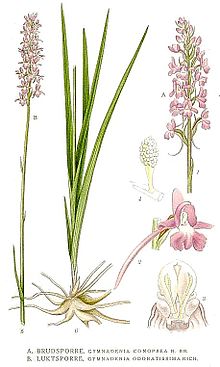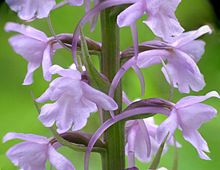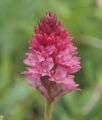Mosquito-Handelwurz
| Mosquito-Handelwurz | ||||||||||||
|---|---|---|---|---|---|---|---|---|---|---|---|---|

Mosquito Haendelwurz ( Gymnadenia conopsea ) |
||||||||||||
| Systematics | ||||||||||||
|
||||||||||||
| Scientific name | ||||||||||||
| Gymnadenia conopsea | ||||||||||||
| ( L. ) R.Br. |
The mosquito Händelwurz ( Gymnadenia conopsea ), also long spur Händelwurz , Flying Händelwurz or Large Händelwurz called, is a plant that the genus gymnadenia ( Gymnadenia ) within the family of orchids is one (Orchidaceae).
Description and ecology
Vegetative characteristics
The Mosquito-Haendelwurz is a perennial herbaceous plant and reaches heights of 30 to 80 centimeters. The tubers of this tuber geophyte are thick, flattened, two-columned, with short lobes divided in the shape of a hand. There is an endotrophic orchid-type mycorrhiza .
Generative characteristics
Flowering time is May to July. Many flowers stand together in an inflorescence. The hermaphrodite flowers are zygomorphic and threefold. The more or less strongly scented flowers are pink to dark purple-red. The three-lobed lip ( labellum ) and the thread-like, downward-curved spur , which is 10 to 20 millimeters long and longer than the ovary , are typical of the flower . The long spur makes it easy to distinguish the species from the similar-looking orchid species. The nectar secreted in abundance by the flowers is visible in the backlight. Since the entrance of the spur is less than 1 millimeter open, the nectar is only accessible to butterflies, both butterflies and moths . The most common pollinators are the little owl ( Deilephila porcellus ), the pigeon tail ( Macroglossum stellatarum ) (Sphingidae), the gamma owl ( Autographa gamma ), the brass owl ( Diachrysia chrysitis ) and the house mother ( Noctua pronuba ) (Noctuidae). The pollinia are covered by small pouches. The narrow, bare adhesive body is directed downwards. The smell is more or less pleasant, sometimes it is absent. Plenty of extra-floral nectar is offered on the supporting leaves of the flowers. B. accepted by ants .
The capsule fruits open with crevices and are wind spreaders. The fruit set is high, averaging 73%. The tiny seeds spread out like granular flyers ; their weight is only 0.008 mg. There are several thousand seeds per capsule fruit. The fruit ripens from August.
The number of chromosomes is 2n = 40 or 80.
Attractants and pollinators
45 volatile aromatic substances that attracted butterflies were detected by gas chromatography , of which 37 species could be identified. Benzyl acetate , eugenol and benzyl benzoate have been identified as active attractants . The smell of the mosquito-handelwurz, spread in the distribution area of the fragrant hendelwurz , could not attract pollinators for the mosquito-handelwurz. In a day-night rhythm , the flowers gave off different attractive aromas.
Occurrence and endangerment
The distribution area of Gymnadenia conopsea extends from Europe to Japan. In Europe, it is particularly common in northern Europe. It occurs only sporadically in Central Europe in the lowlands, and it is absent in areas on sand and over silicate rock. Otherwise it occurs scattered in Central Europe, and it sometimes occurs in larger populations at its locations. In Austria , the mosquito-Händelwurz occurs moderately frequently in all federal states.
In parts of the distribution area, the mosquito-handelwort is considered endangered and has therefore been included in the red list , e.g. B. in Hessen (see under web links).
The mosquito-handelwort thrives best on calcareous or base-rich, nitrogen-poor loam soils that should be at least temporarily moist. Lean grasslands , pine forests , wet and wet meadows , flat and spring moors are preferred as locations . In Central Europe it inhabits light deciduous forests , dry grassland (in places where slope pressure water escapes or seeps close below the surface), swamp meadows, spring swamps and fens . In the Alps it rises to altitudes of 2500 meters. In the Allgäu Alps it grows on the Kleiner Rappenkopf in Bavaria up to an altitude of 2200 meters. According to Baumann and Künkele , the species has the following altitude limits in the Alpine countries: Germany 10–2117 meters, France 5–2500 meters, Switzerland 390–2800 meters, Liechtenstein 430–2100 meters, Austria 120–2400 meters, Italy 10–2600 meters, Slovenia 20-2060 meters. For Europe the limits are 5 and 2800 meters above sea level. The species thrives in plant communities of the associations Molinion, Calthion, Mesobromion, Geranion sanguinei, Erico-Pinion, in the high mountains also the order Seslerietalia.
Taxonomy
It was first published in 1753 under the name ( Basionym ) Orchis conopsea by Carl von Linné in Species Plantarum . S. 942. The new combination to Gymnadenia conopsea (L.) R.Br. was published in 1813 by Robert Brown in WT Aiton: Hortus Kew. , Volume 5, p. 191 published. Other synonyms for Gymnadenia conopsea (L.) R.Br. s. st. are: Satyrium conopseum (L.) Wahlenb. , Habenaria conopsea (L.) Benth. nom. illeg., Habenaria Gymnadenia Druce , Orchis cornopica Mill. orth. var., Orchis ornithis Jacq. , Orchis setacea Gilib. , Orchis suaveolens Salisb. , Orchis peloria Foucault ex Poir. , Orchis pseudoconopsea P.E.Parm. , Orchis pseudoconopea Gren. , Orchis conopea Gras , × Dactylodenia comigera (Rchb.) Aver. , × Dactylogymnadenia comigera (Rchb.) Rauschert , × Orchigymnadenia comigera (Rchb.) Asch. & Graebn. , Gymnadenia ornithis (Jacq.) Rich. , Gymnadenia comigera Rchb. , Gymnadenia sibirica Turcz. ex Lindl. , Gymnadenia anisoloba Peterm. , Gymnadenia wahlenbergii Afzel. ex Rchb. f. , Gymnadenia angustifolia Ilse nom. illeg., Gymnadenia ibukiensis Makino , Gymnadenia pseudoconopsea (PEParm.) Rouy , Gymnadenia splendida Dworschak , Gymnadenia vernalis Dworschak , Gymnadenia transsilvanica Schur , Gymnadenia graminea Dworschak , Gymnadenia alpina (Turp. ex Rchbere) Cz. , Gymnadenia densiflora var. Candida G. Foelsche & W.Foelsche , Gymnadenia conopsea subsp. comigera (Rchb.) K. Richt . , Gymnadenia conopsea subsp. peloria (Foucault ex Poir.) K. Richt . , Gymnadenia conopsea subsp. angustifolia (Asch. & Graebn.) Zimm. , Gymnadenia conopsea subsp. serotina (Schönh.) Dworschak , Gymnadenia conopsea var. alba Gray , Gymnadenia conopsea var. praecox Schönh. , Gymnadenia conopsea var. Serotina Schönh. , Gymnadenia conopsea var. Alpina Turcz. ex Rchb. f. , Gymnadenia conopsea var. Clavata Rchb. f. , Gymnadenia conopsea var. Ecalcarata Rchb. f. , Gymnadenia conopsea var. Inodora Fr. ex Rchb. f. , Gymnadenia conopsea var. Platyphylla Rchb. f. , Gymnadenia conopsea var. Sibirica (Turcz. Ex Lindl.) Rchb. f. , Gymnadenia conopsea var. Ussuriensis rule , Gymnadenia conopsea var. Ornithis (Jacq.) Nyman nom. superfl., Gymnadenia conopsea var. crenulata Beck , Gymnadenia conopsea var. leucantha Schur , Gymnadenia conopsea var. albiflora Zapal. , Gymnadenia conopsea var. Angustifolia Asch. & Graebn. , Gymnadenia conopsea var. Bieczensis Zapal. , Gymnadenia conopsea var. Trifida Zapal. , Gymnadenia conopsea var. Lapponica J.E.Zetterst. , Gymnadenia conopsea var. Caucasica Schltr. , Gymnadenia conopsea var. Latifolia Schltr. , Gymnadenia conopsea var. Flavida Kurt Wagner , Gymnadenia conopsea var. Neglecta Vöth . No subtaxa are accepted.
Natural hybrids
Gymnadenia conopsea often forms hybrids with: Gymnadenia odoratissima , Nigritella rhellicani and very rarely with Pseudorchis albida .
photos
Inflorescence with six-spot ram
literature
- Manfred A. Fischer, Wolfgang Adler, Karl Oswald: Excursion flora for Austria, Liechtenstein and South Tyrol . 2nd, improved and enlarged edition. State of Upper Austria, Biology Center of the Upper Austrian State Museums, Linz 2005, ISBN 3-85474-140-5 .
- Oskar Angerer, Thomas Muer: Alpine plants (= Ulm nature guide ). Eugen Ulmer, Stuttgart (Hohenheim) 2004, ISBN 3-8001-3374-1 .
- Ruprecht Düll , Herfried Kutzelnigg : Pocket dictionary of plants in Germany and neighboring countries. The most common Central European species in portrait . 7th, corrected and enlarged edition. Quelle & Meyer, Wiebelsheim 2011, ISBN 978-3-494-01424-1 .
- Hans Joachim Conert (Hrsg.): Illustrated flora of Central Europe . Founded by Gustav Hegi. 3rd, completely revised edition. Volume I. Part 3: Spermatophyta: Angiospermae: Monocotyledones 1 (2). Poaceae (real grasses or sweet grasses) . Parey Buchverlag, Berlin 1998, ISBN 3-8263-2868-X (published in deliveries 1979–1998).
- J. Claessens, J. Kleynen: The flower of the European Orchid - Form and function , self-published, 2011, ISBN 978-90-9025556-9 .
Individual evidence
- ↑ a b Erich Oberdorfer : Plant-sociological excursion flora for Germany and neighboring areas. 8th edition. Stuttgart, Verlag Eugen Ulmer, 2001. Page 276. ISBN 3-8001-3131-5
- ↑ a b c d Franz K. Huber, Roman Kaiser, Willi Sauter, Florian P. Schiestl: Floral scent emission and pollinator attraction in two species of Gymnadenia (Orchidaceae). In: Oecologia , Volume 142, 2005, pp. 564-575, doi : 10.1007 / s00442-004-1750-9 ( PDF ).
- ↑ a b c Rafaël Govaerts (Ed.): Gymnadenia conopsea. In: World Checklist of Selected Plant Families (WCSP) - The Board of Trustees of the Royal Botanic Gardens, Kew . Retrieved December 1, 2016.
- ↑ Erhard Dörr, Wolfgang Lippert : Flora of the Allgäu and its surroundings. Volume 1, IHW, Eching 2001, ISBN 3-930167-50-6 , p. 380.
- ↑ a b Helmut Baumann , Siegfried Künkele : Orchidaceae . In: Oskar Sebald u. a .: The fern and flowering plants of Baden-Württemberg. 1st edition Volume 8, page 346. Verlag Eugen Ulmer, Stuttgart 1998. ISBN 3-8001-3359-8
- ^ Gymnadenia conopsea x Pseudorchis albida. In: FloraWeb.de.
Web links
- Gymnadenia conopsea (L.) R. Br. S. str., Great Haendelwurz (ie p.). In: FloraWeb.de.
- Gymnadenia conopsea (L.) R. Br. Sl, Große Händelwurz (iw S.). In: FloraWeb.de.
- Profile and distribution map for Bavaria . In: Botanical Information Hub of Bavaria .
- Profile and distribution map for Bavaria . In: Botanical Information Hub of Bavaria .
- Distribution in the northern hemisphere
- Thomas Meyer: Data sheet with identification key and photos at Flora-de: Flora von Deutschland (old name of the website: Flowers in Swabia ).
- The orchids of the Rhön: Mückenhändelwurz ( Gymnadania conopsea )
- Orchids of the southern Styria Gymnadenia Handelwurz
- Red list of the plant species in Hesse.
- AGEO Switzerland.
- Distribution map of Switzerland (AGEO).








